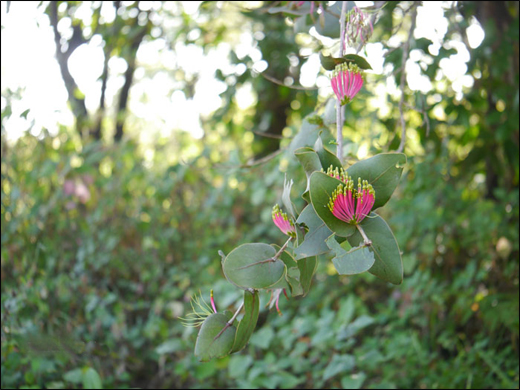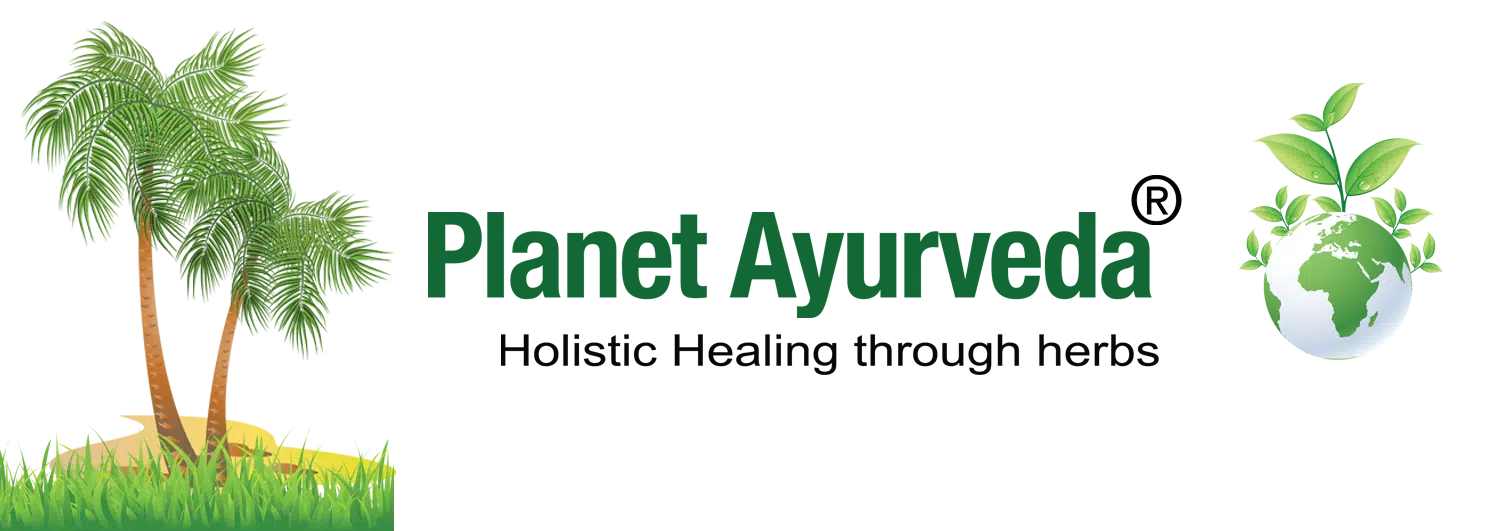Banda/ Loranthus Longiflorus Desr./ Dendrophthoe falcata/ Viscum album Linn.
Abstract
Loranthus longiflorus Desr., a hemiparasitic plant belonging to the Loranthaceae family, is traditionally used in various indigenous systems of medicine, including Ayurveda. It is known for its potent therapeutic properties, particularly in the treatment of inflammatory conditions, ulcers, wounds, and systemic disorders. This article explores its botanical profile, therapeutic uses, phytochemical constituents, and compares it with its closely related species, Viscum album Linn., commonly known as European mistletoe.

Introduction
Bandaka (Dendrophthoe falcata) is a parasitic plant recognised in Ayurvedic literature for its diverse therapeutic applications. It is traditionally used in the management of diarrhoea, inflammatory swellings, renal calculi (kidney stones) and neurological disorders such as epilepsy. In addition, it is valued for its role in garbha raksha, the protection and maintenance of fetal health during pregnancy. The plant’s unique bioactive constituents are believed to support various physiological systems, making it an important remedy in Ayurvedic obstetrics and general medicine.
Scientific Classification
- Kingdom – Plantae
- Division – Angiosperms
- Class – Eudicots
- Order – Santalales
- Family – Loranthaceae
- Genus – Loranthus
- Species – L. longiflorus Desr.
Synonyms
- Padaparuha – That which grows on trees
- Vṛkṣadānī – Tree-clinger or dependent on trees
- Vṛkṣāruha – One that climbs or grows on trees
- Vṛkṣhabhakṣya – Feeds on trees (parasitic nature)
- Tāruruha – Grows on tree trunks or branches
- Saṁharsa – Possibly referring to a stimulating or exciting effect
- Gandhabhedinī – That which has a distinct or penetrating fragrance
- Tārubhakṣa – Consumes the host tree
- Drupadī – Associated with tree sap or exudates
- Śekharī – Ornamental or crown-like (referring to its appearance on trees)
- Kāmarūpaka – Changing or taking on various forms (possibly due to its spread)
- Kāminī – Attractive or beautiful in appearance
- Padmarūpiṇī – Lotus-like in form or elegance
Vernacular Names
- Hindi – Bandaa, Banda, Banda Patha
- English – Mistletoe, Honey Suckle
- Bengali – Maandaa, Bandha, Pharulla
- Gujarati – Baando, Bando
- Kannada – Badanike, Maduka
- Konkani – Bemdram
- Kashmiri – Ittikkanni, Itil
- Malayalam – Itil, Ittikkanni
- Marathi – Bandagul, Bandgul, Vanda
- Punjabi – Pulluri
- Tamil – Baadanikaa, Jiddu
- Telugu – Jeevakamu, Badanika, Jiddu, Yelinga
Habitat
Banda (Dendrophthoe falcata) is a hemiparasitic, flowering shrub native to India, Sri Lanka, Thailand, the Indo-China region, and Australia. It is a highly branched, bushy plant belonging to the group of parasitic species commonly known as mistletoes, which attach themselves to host trees to derive water and nutrients, while still performing some photosynthesis independently. Although Dendrophthoe falcata is capable of photosynthesis, it relies on its host plant for water, minerals, and essential nutrients. It establishes a parasitic connection by penetrating the host’s xylem and phloem tissues through specialised structures called haustoria, effectively extracting sustenance and weakening the host over time.
Morphology
The leaves of Dendrophthoe falcata are simple, leathery, thick and evergreen. They are entirely in margin, persistent and can be sessile or semi-sessile, measuring approximately 7.5 — 18 cm in length and 2–10 cm in width. The leaves are petiolate, exstipulate and arranged alternately, oppositely, or sometimes in whorls of three. The flowers are large, tubular, bisexual and strikingly bright red, typically borne in clusters arranged along a spike. The fruit is a pseudocarp, formed by the fusion of the ovary with the receptacular cup, resulting in a berry-like, single-seeded fruit. Interestingly, the therapeutic application of Banda (another name for Dendrophthoe falcata) in traditional medicine may vary depending on the host plant, as the parasite absorbs water and minerals directly from its host, potentially influencing its medicinal properties.
Varieties
Viscum album, commonly known as European mistletoe, is another hemiparasitic plant from the Santalaceae family (previously classified under Loranthaceae). It is native to Europe and parts of Asia and has been traditionally used in Western herbal medicine. It grows on deciduous trees like apple, oak, and poplar. Viscum album has evergreen leaves, small yellowish-green flowers, and white berries that are toxic if ingested. Unlike L. longiflorus, it prefers temperate climates.
Therapeutic Properties
- It is effective in the management of heart diseases and ascites.
- It is useful in splenomegaly, epilepsy, haemorrhoids, injuries, wounds and ear discharge.
Classical Categorisation
- According to Dhanvantari Nighantu – Karaveeradi Varga
- According to Bhavaprakasha Nighantu – Guduchyadi Varga
- According to Raj Nighantu – Parpatadi Varga
Ancient Verses
वन्दाकः स्थाद्धिमस्तिक्तः कषायो मधुरो रसे । मङ्गल्यः कफवातास्त्ररक्षोव्रणविषापहः ॥
(Bhavprakash Nighantu Guduchyadi Varga 261)
According to the above shloka, Banda has bitter, sweet and astringent taste, balances Kapha dosha, is effective in gout, wounds and poison.
Ayurvedic Properties
- Taste (Rasa) – Bitter (Tikta), Sweet (Madhur), Astringent (Kashaya)
- Physical property (Guna) – Light (Laghu)
- Potency (Veerya) – Cold Potency (Sheet)
- Post-digestion effect (Vipaka)- – Katu (Pungent)
- Effect on tridosha – Balance Pitta and Kapha dosha
Therapeutic Properties
- Anti-inflammatory
- Analgesic
- Antioxidant
- Wound-healing
- Immunomodulatory
- Anti-ulcer
- Antimicrobial
- Hepatoprotective
Systemic Actions
Externally
It possesses anti-inflammatory properties and is applied topically in cases of wounds, cuts and skin abrasions.
Internal Use
- Nervous System – It acts as a nervine tonic and is beneficial in conditions like epilepsy, hysteria and convulsions.
- Digestive System – It works as an absorbent and is useful in managing diarrhoea, dysentery, and hematochezia (bloody stools).
- Circulatory System – It helps in controlling bleeding disorders and oedema and supports healthy cardiac function.
- Respiratory System – Banda alleviates Kapha dosha and is indicated in cough, bronchial asthma and other respiratory ailments.
- Reproductive System – It acts as Garbhasthapaka (supports fetal retention and sustains pregnancy).
- Excretory System – It is effective in urinary conditions such as kidney stones (Asmari) and painful urination (dysuria).
Chemical Composition
- Quercitrin
- Gallic acid
- Ellagic acid
- Chebulinic acid
- Kaempferol
- Rutin
- Tannins
- β-sitosterol
- Stigmasterol
- β-amyrin
- Oleanolic acid
Modern Overview
Anti-tumour Activities
In vitro studies have demonstrated that various extracts of Dendrophthoe falcata exhibit notable cytotoxic activity against multiple cancer cell lines, including breast cancer (MCF-7), Ehrlich ascitic carcinoma, skin cancer, chronic myeloid leukaemia and myeloma cells. Among these, the MCF-7 breast cancer cell line served as a primary model. The methanolic extract of Dendrophthoe falcata leaves showed significant antiproliferative effects within a concentration range of 0.04 μg/mL to 100 μg/mL, with an IC₅₀ value of 10.65 μg/mL. This anticancer effect is believed to be associated with the upregulation of pro-apoptotic markers such as p53 and BAX and downregulation of the anti-apoptotic gene BCL-2.
Antifertility Activities
The antifertility potential of the traditionally used plant Dendrophthoe falcata (L.f.) was evaluated through oral administration in adult female Wistar rats. The study focused on its effects on the female reproductive system, fertility, and overall safety. Results indicated that the hydroalcoholic extract of the aerial parts exhibited a significant antifertility effect and was safe at the tested effective doses. The LD₅₀ value of the extract was determined to be 4.55 g/kg of body weight, indicating a relatively safe toxicity profile.
Wound Healing Activities
Traditionally, the fresh leaves and stems of Dendrophthoe falcata are ground into a paste with water and applied topically to wounds to promote healing. Scientific studies have supported this use, showing that the ethanolic extract of the aerial parts possesses significant wound-healing activity. When tested on excision and incision wound models in rats, the extract demonstrated notable healing potential, as evidenced by accelerated wound contraction and enhanced tensile strength of the healed tissue.
Practical Uses
- A paste made from the leaves of Bandaka is applied to wounds to promote faster healing.
- Leaf juice of Dendrophthoe falcata is administered in doses of 10–15 ml to manage kidney stones and urinary retention.
- Fresh leaf juice is used for treating diarrhoea in doses of 5–10 ml mixed with buttermilk.
- The leaf paste is applied externally to areas affected by swelling and pain.
- The plant’s juice is used as a remedy for epilepsy and various psychiatric disorders.
- Juice of Bandaka is given to support fetal retention in cases of threatened miscarriage.
Part Used
Whole plant
Dosage
- Fresh juice – 10-20 ml
- Fruit – 500-1500 mg
Conclusion
Loranthus longiflorus Desr. is a valuable medicinal plant with a rich history in traditional medicine. Its wide range of pharmacological actions, from anti-inflammatory to wound-healing properties, makes it useful in treating numerous conditions. The plant’s versatility is mirrored in its European counterpart, Viscum album, which also holds significant therapeutic promise. Both species warrant further clinical studies to validate and optimise their medicinal use in modern healthcare systems.



